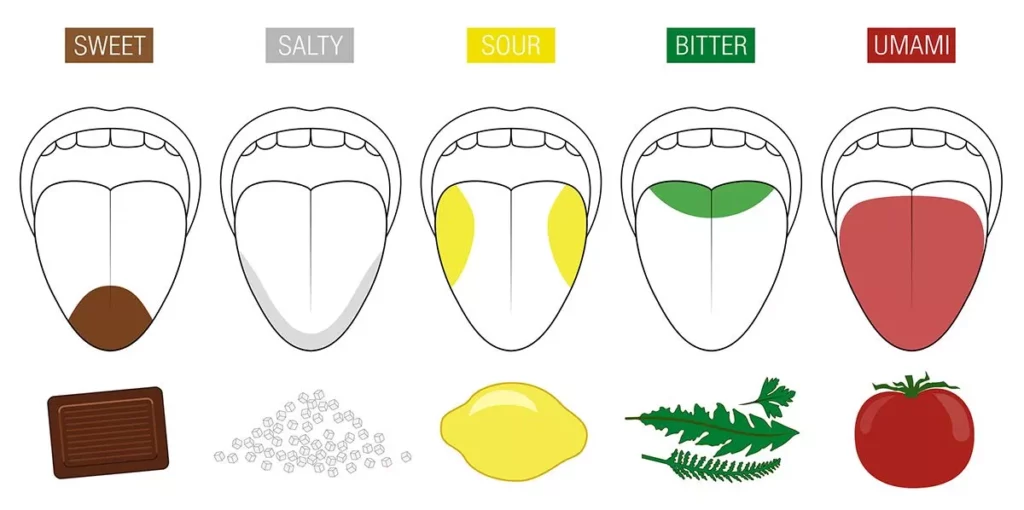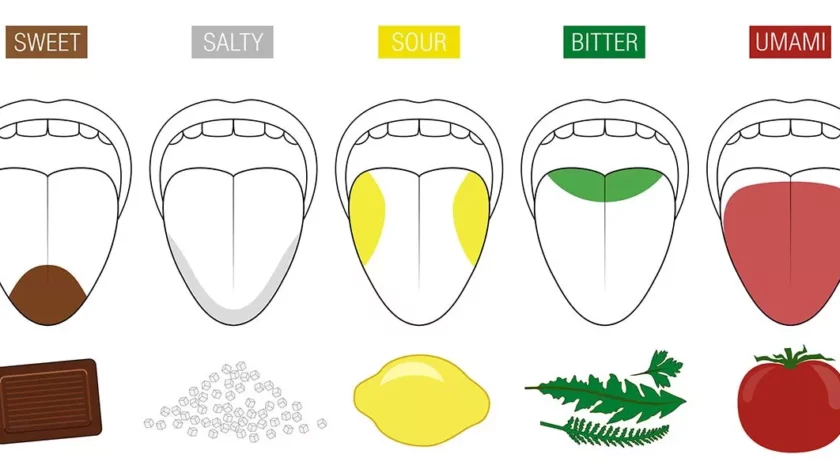What Are Taste Buds?
Contents
Taste buds are a must to savor our favorite dishes. these are present in our tongues and are not visible to the human eyes.
NOTE: The average human is born with around 10,000 taste buds and they are replaced every 2 weeks or so. and older people have 5000 taste buds.
Taste buds are able to identify 5 basic tastes:
- Salt
- Sour
- Sweet
- Umami – Is the word we used to refer to incredibly delicious foods.
- Bitter
The taste buds contain taste receptors also called taste cells.
Taste receptors are located around small structures called “papillae” found on the upper surface of the gullet, cheek, and upper esophagus.

What Are Papillae In Tongue?
Most of the taste buds on the tongue sit on raised projections and these projections are known as the papillae.
There are 5 types of papillae include:
- Vallate papillae: This papilla is situated on the back of the oral part of the teeth also known as circumvallate papillae.
They are the largest being in diameter and 8-12 in number.
- Foliate papillae: These are present on each side of the tongue.
Is present anteriorly are innervated by the facial nerve and those present backward are innervated by the glossopharyngeal nerve.
- Fungiform papillae: They look like mushrooms, it is through to work to increase the area of the tongue and to increase the area of contact and friction between the tongue and the food.
- Filiform papillae: These cover most of the area anterior to the sulcus terminalis and do not contain taste buds.
It is responsible for the texture of the tongue and also for the sensation of touch.
- Papillae simplex: They are only seen in a microscope since they are not surface projections.
It is the nipple-like structure in the middle of the tongue that gives it a distinctive rough texture.
How Do Buds Work?
For example – when we put a fruit or any dish in our mouth, then the chemical substance of the dish communicates with the taste buds on the tongue.
- Then the taste buds send dish information to the brain, the brain recognizes the type of taste and decides whether we like what we are taking or not.
Does Taste Change Over Time?
Yes, the taste buds change over time but why? Because one common reason that occurs in all people is aging.
Remember 10,000 taste buds, which decrease over time, and we experience decreasing insensitivity.
Reasons for Change In Taste
There Is some other reason that causes taste buds not to work including:
- Viral and infection: such as cold, In this our body receptors do not detect an odour, which causes taste and smell not to work.
- Medical condition: Gastroesophageal reflux disease, salivary gland infection, poor dental hygiene, which is a sign of loss of taste.
- Other condition affects the brain, nose, and mouth, resulting in a change in our taste buds.
- Smoking: Smoking affects the long-term, over time the chemicals present in cigarettes damage nerves and end in the nose, causing loss of smell.
- Certain medicine: Different medications might cause a change in taste, which leads to dry mouth, which makes it hard for the taste buds to identify the taste.
- Nutrition deficiencies: Lack of nutrition can also contribute to a reduced ability to taste food, minerals, and vitamins are vital for the taste buds to analyze dish taste.
Short-Time Loss In Taste, and Smell
NOTE: Short-time like – when we have a cold, but why we can’t smell or taste when we have a cold?
1. For the nose: Because our nose has specialized olfactory receptors, covered in a thin layer of mucus.
In normal conditions, the aroma of food and perfume travels through our nose and nose receptors, which makes us feel so good.
But, In cold conditions, our noses produce a lot of mucus, due to which the fragrance does not reach the receptor and we do not know the smell.
2. For a taste: When we bite food, specialized gustatory receptors on our tongue, tell us whether the food is sweet or salty.
However, at the same time, the smell from food travels back to our mouth to the olfactory receptors.
Then, the blend of both taste and smell receptors gives our mind a full picture of flavour.
But, when we have a cold, the olfactory receptors cannot detect the scents. then we don’t get a full sense of taste and flavour.
Can Situation Change Our Taste?
Yes, taste changes according to the environment where you are eating the food, for example – In Airplane food tastes are not similar to ground.
NOTE: Researchers have shown that the major part of this problem is the plane itself.
Plane air pressure reduces humidity and even outer noise in the cabin, which can all reduce our ability to taste sweet and salty foods.
“Emotions” also play a vital role in better taste but how?
NOTE: In another study at a hockey ground, where the fans are asked to rate the taste of the Ice cream.
As a result, the team that won, and their fans rated the taste of the ice cream higher.
Compared to other teams’ fans.
What Is The Relation of Taste and Smell In Covid?

A loss of smell and taste are the common symptoms of covid-19 if anyone sees any symptoms of covid then starts isolating themselves, inlclude:
- Fever
- Loss of smell and taste
- Unusual taste
NOTE: But what does covid do that reduces our taste and smell?
As we know that covid has ACE-2 receptors which get attached to our nose receptors, and this is the reason why doctors detect covid through our nose.
Home-Remedies For Regaining Taste, and Smell
If you facing long-term no Taste, so this also could be caused by nerve damage.
In case of any infection and viral cold, it can resolve on its own, or with some home remedy and medicine.
Here are some home remedies include:
- Take an inch of cinnamon piece and a clove put these inside your mouth and suck its flavor slowly.
- Do these 2 to 3 times a day, it slowly restores your taste buds.
- Castor oil contains ricinoleic acid and has been found to have beneficial impacts in resorting to the taste buds’ function because it has anti-inflammatory agents.
Down Line
Most of the taste buds on the tongue sit on raised projections and these projections are known as the papillae.
The average human is born with around 10,000 taste buds and they are replaced every 2 weeks or so.
Smoking affects in the long-term, over time the chemicals present in cigarettes damage nerves-ending in the nose, causing loss of smell.
Aging is a common reason which decreases our taste buds.





This is very interesting, You’re a very skilled blogger. I’ve joined your rss feed and look forward to seeking more of your excellent post. Also, I’ve shared your website in my social networks!
Thank you,and please share as far as possible, read other post, and thanks once again.